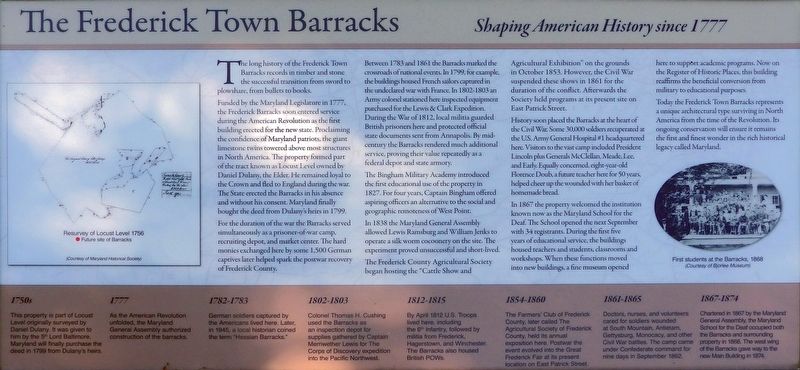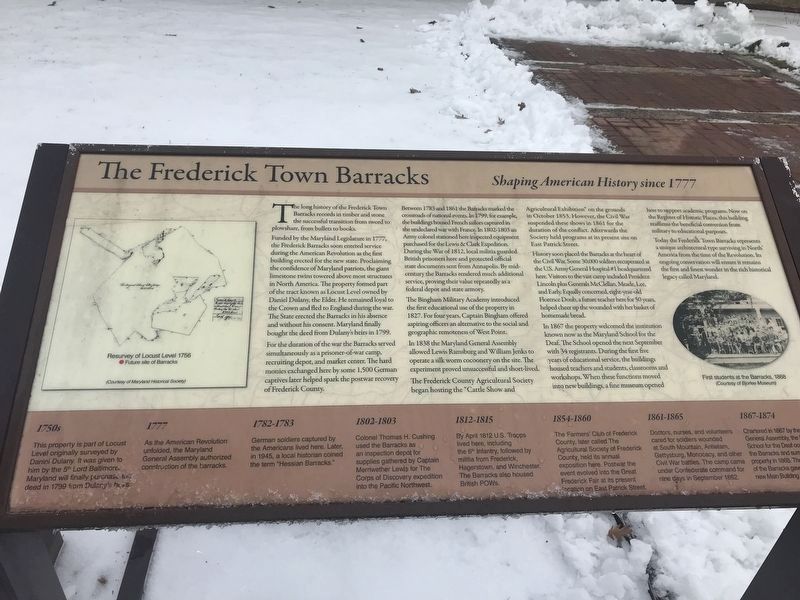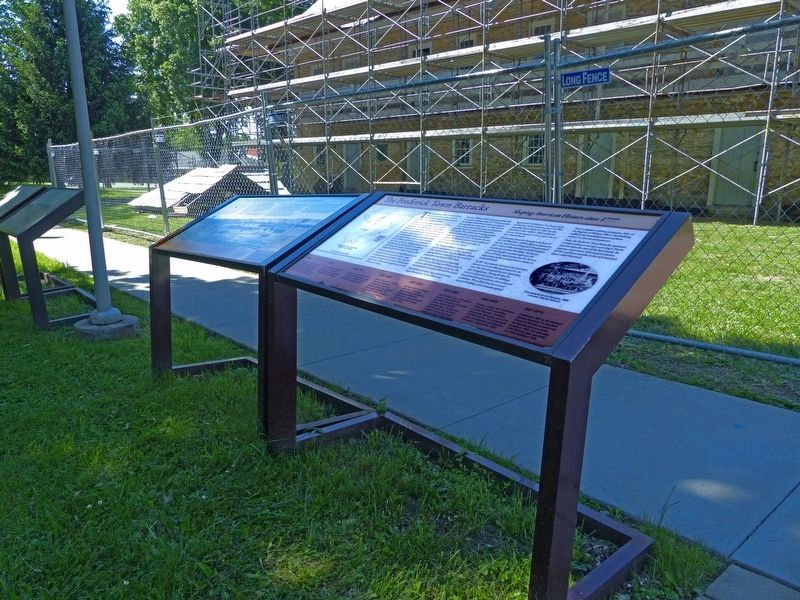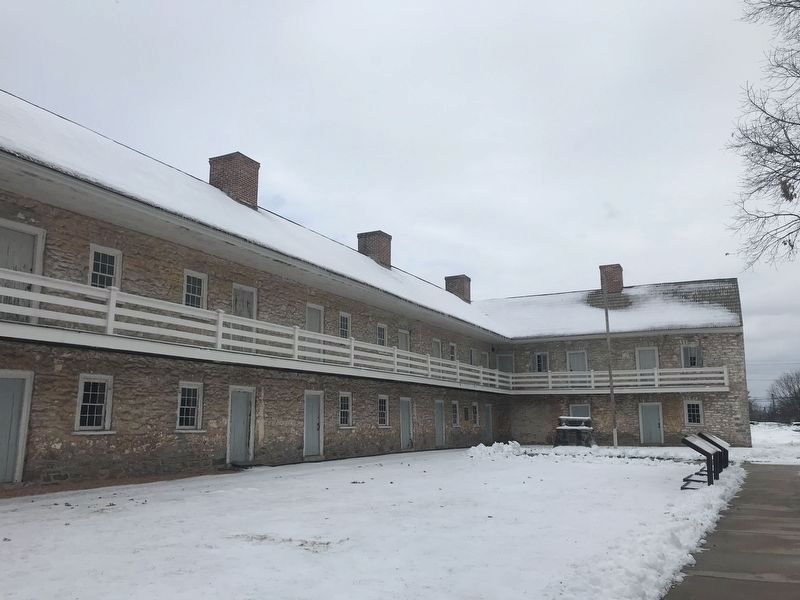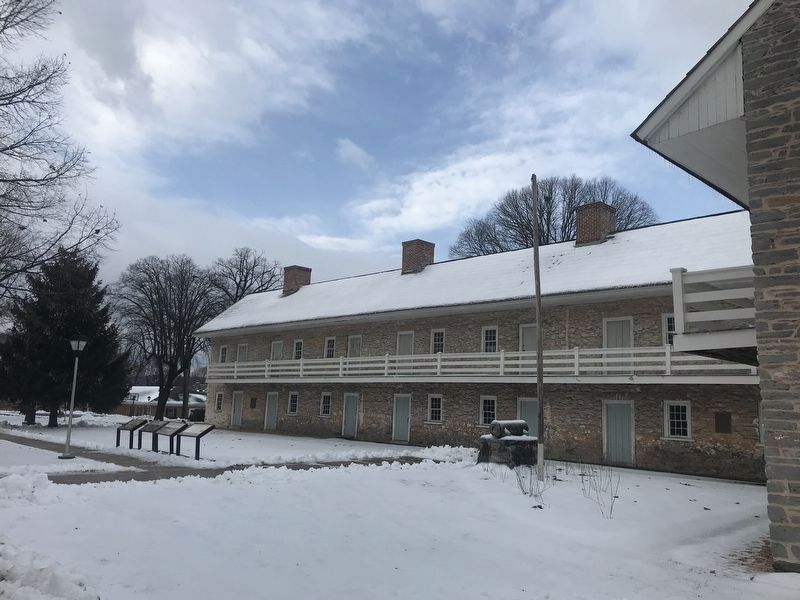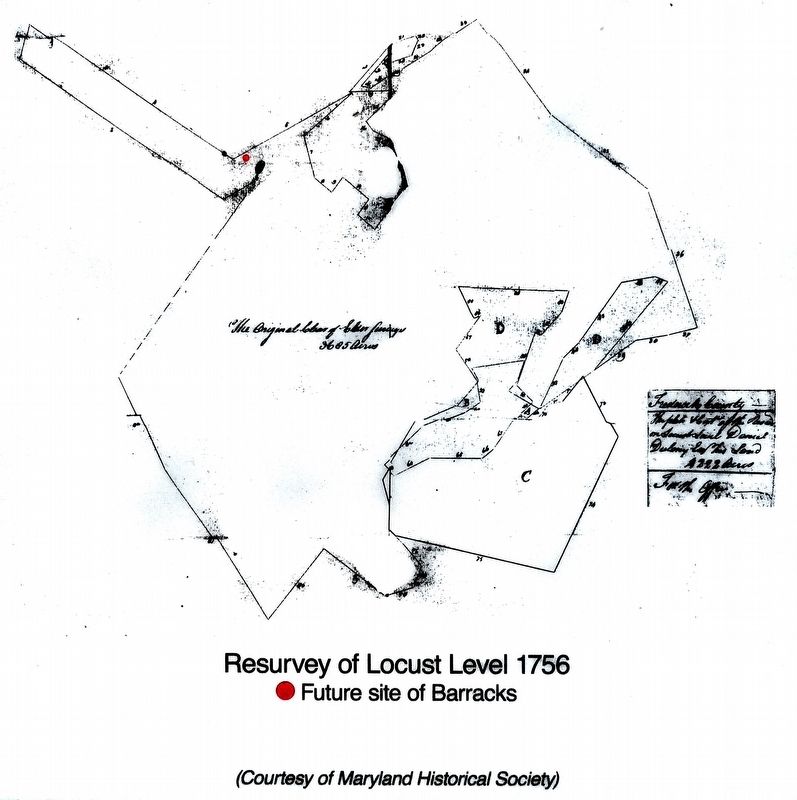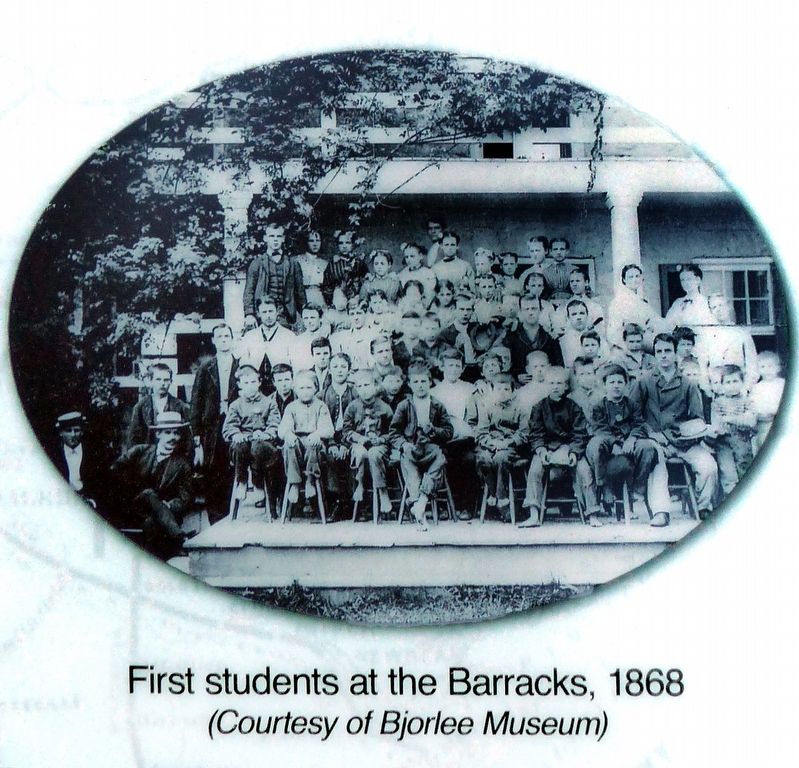Frederick in Frederick County, Maryland — The American Northeast (Mid-Atlantic)
The Frederick Town Barracks
Shaping American History since 1777
Funded by the Maryland Legislature in 1777, the Frederick Barracks soon entered service during the American Revolution as the first building erected for the new state. Proclaiming the confidence of Maryland patriots, the giant limestone twins towered above most structures in North America. The property formed part of the tract known as Locust Level owned by Daniel Dulany, the Elder. He remained loyal to the Crown and fled to England during the war. The State erected the Barracks in his absence and without his consent. Maryland finally bought the deed from Dulany's heirs in 1799.
For the duration of the war the Barracks served simultaneously as a prisoner-of-war camp, recruiting depot, and market center. The hard monies exchanged here by some 1,500 German captives later helped spark the postwar recovery of Frederick County.
Between 1783 and 1861 the Barracks marked the crossroads of national events. In 1799, for example, the buildings housed French Sailors captured in the undeclared war with France. In 1802-1803 an Army colonel stationed here inspected equipment purchased for the Lewis & Clark Expedition.
During the War of 1812, local militia guarded British prisoners here and protected official state documents sent from Annapolis. By mid-century the Barracks rendered much additional service, proving their value repeatedly as a federal depot and state armory.
The Bingham Military Academy introduced the first educational use of the property in 1827. For four years, Captain Bingham offered aspiring officers and alternative to the social and geographic remoteness of West Point.
In 1838 the Maryland General Assembly allowed Lewis Ramsburg and William Jenks to operated a silk worm cocoonery on the site. The experiment proved unsuccessful and short-lived.
The Frederick County Agricultural Society began hosting the “Cattle Show and Agricultural Exhibition” on the grounds in October 1853. However, the Civil War suspended these shows in 1861 for the duration of the conflict. Afterwards the Society held programs at its present site on East Patrick Street.
History soon placed the Barracks at the heart of the Civil War. Some 30,000 soldiers recuperated at U.S. Army General Hospital #1 headquartered here. Visitors to the vast camp included President Lincoln plus Generals McClellan, Meade, Lee, and Early. Equally concerned, eight-year-old Florence Doub, a future teacher here for 50 years, helped cheer up the wounded with her basket of homemade bread.
In 1867 the property welcomed the institution known now as the Maryland School for the Deaf. The School opened the next September with 34 registrants. During the first five years of educational service, the buildings housed teachers and students, classrooms and workshops. When these functions moved into new buildings, a fine museum opened here to support academic programs. Now on the Register of Historic Places, this building reaffirms the beneficial conversion from military to educational purposes.
Today the Frederick Town Barracks represents a unique architectural type surviving in North America from the time of the Revolution. Its ongoing conservation will ensure it remains the first and finest wonder in the rich historical legacy called Maryland.
1750s — This property is part of Locust Level originally surveyed by Daniel Dulany. It was given to him by the 5th Lord Baltimore. Maryland will finally purchase the deed in 1799 from Dulany's heirs.
1777 — As the American Revolution unfolded, the Maryland General Assembly authorized construction of the Barracks.
1782 - 1783 — German Soldiers captured by the Americans lived here. Later, in 1945, a local historian coined the term “Hessian Barracks.”
1802 - 1803 — Colonel Thomas H. Cushing used the Barracks as an inspection depot for supplies gathered by Captain Merriwether
Lewis for the Corps of Discovery expedition into the Pacific Northwest.
1812 - 1815 — By April 1812 U.S. Troops lived here, including the 6th Infantry, followed by militia from Frederick, Hagerstown, and Winchester. The Barracks also housed British POWs.
1854 - 1860 — The Farmers' Club of Frederick County, later called the Agricultural Society of Frederick county, held its annual exposition here. Postwar the event evolved into the Great Frederick Fair at its present location on East Patrick Street.
1861 - 1865 — Doctors, nurses, and volunteers cared for soldiers wounded at South Mountain, Antietam, Gettysburg, Monocacy, and other Civil War Battles. The camp came under Confederate command for nine days in September 1862.
1867 - 1874 — Chartered in 1867 by the Maryland General Assembly, the Maryland School for the Deaf occupied both the Barracks and surrounding property in 1868. The west wing of the Barracks gave way to the new Main Building in 1874.
Topics and series. This historical marker is listed in these topic lists: Education • War of 1812 • War, US Civil • War, US Revolutionary. In addition, it is included in the Former U.S. Presidents: #16 Abraham Lincoln series list.
Location. 39° 24.533′ N, 77° 24.581′ W. Marker is in Frederick, Maryland, in Frederick County. Marker can be reached from Clarke Place. At the Maryland School for the Deaf. Touch for map. Marker is at or near this postal address: 101 Clarke Place, Frederick MD 21705, United States of America. Touch for directions.
Other nearby markers. At least 8 other markers are within walking distance of this marker. United States Army General Hospital #1 (here, next to this marker); Historic Frederick Barracks (here, next to this marker); “The Great Baby Waker” (a few steps from this marker); Hessian Barracks - Witness to History (a few steps from this marker); These Barracks (a few steps from this marker); a different marker also named Frederick Town Barracks (within shouting distance of this marker); Lewis & Clark Trail Marker (within shouting distance of this marker); The Frederick Brick Works (approx. 0.2 miles away). Touch for a list and map of all markers in Frederick.
Credits. This page was last revised on January 20, 2022. It was originally submitted on May 12, 2017, by Allen C. Browne of Silver Spring, Maryland. This page has been viewed 363 times since then and 26 times this year. Photos: 1. submitted on May 12, 2017, by Allen C. Browne of Silver Spring, Maryland. 2. submitted on January 17, 2022, by Adam Margolis of Mission Viejo, California. 3. submitted on May 12, 2017, by Allen C. Browne of Silver Spring, Maryland. 4, 5. submitted on January 17, 2022, by Adam Margolis of Mission Viejo, California. 6, 7. submitted on May 12, 2017, by Allen C. Browne of Silver Spring, Maryland. • Bill Pfingsten was the editor who published this page.
